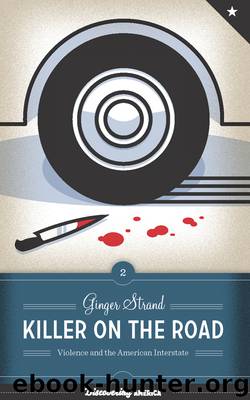Killer on the Road by Ginger Strand

Author:Ginger Strand
Language: eng
Format: epub
Publisher: University of Texas Press
Published: 2012-01-28T16:00:00+00:00
Roger Reece Kibbe, the “I-5 Strangler”: a killer so bland even a mother who put her daughter into his car couldn’t remember any details about him to tell police. Courtesy Sacramento Bee.
Not long after Charmaine Sabrah disappeared, another body was found in the desolate country along I-5. It was Lora Heedick, a Sacramento prostitute. Her case didn’t receive the attention paid the pretty all-American girl or the young mother trying to get home to her baby. But Lora Heedick had also been strangled.
• • • • •
The August that Charmaine Sabrah met her awful fate on the highway, the last five miles of I-80, the first transcontinental interstate, opened to traffic. A celebration was held on the spot, outside Salt Lake City. The occasion reminded some people of industrialist Leland Stanford pounding in the “golden spike” in nearby Promontory, Utah, in 1869. That event, marking the completion of the nation’s first transcontinental railroad, had been celebrated with plenty of pomp and national publicity. The completion of I-80, on the other hand, was a small affair that went largely unnoticed. Neither the secretary of transportation nor the director of the Federal Highway Administration attended. The governor of Utah was conspicuously absent. Of the nation’s major newspapers, only the New York Times covered the story. As Tom Lewis, author of a history of the interstate, points out, what people had come to feel toward the highway system was mostly indifference. “Many accepted the highways as a part of contemporary life and thought little about them,” he writes, “except, on occasion, to complain that they were overcrowded, or falling apart.”
Throughout the seventies, a number of things had become apparent about the interstate highway program. It had mowed down mountains, plowed through communities, and divided up farms with little regard for the opinions of affected citizens. It had cost at least three times what it was expected to cost. It had accelerated white flight from cities, contributed to urban blight, and abetted the spread of environmentally destructive, aesthetically awful suburbia. It had spawned a monotonous national landscape of homogeneous franchise businesses, ticky-tacky homes, eyesore shopping malls, and hideous commercial strips.
After the first wave of antihighway screeds, an increasingly sophisticated critique had evolved. The focus shifted from what the highways destroyed—landscapes, urban communities—to what they created: sprawl. The highway problem could not be separated from what was called “urbanization,” but might better be called “suburbanization.” All those land-eating shopping malls and office parks and subdivisions paving their soulless way over countryside and farmland needed to be stopped, before they turned the nation into a nondescript nowhereland. The Task Force on Land Use and Urban Growth issued a report in 1973 declaring that a “new mood” was afoot in the nation. “Increasingly,” the report declared, “citizens are asking what urban growth will add to the quality of their lives. They are questioning the way relatively unconstrained, piecemeal urbanization is changing their communities and are rebelling against the traditional processes of government and the marketplace which, they believe, have inadequately guided development in the past.
Download
This site does not store any files on its server. We only index and link to content provided by other sites. Please contact the content providers to delete copyright contents if any and email us, we'll remove relevant links or contents immediately.
| Acoustics | Bridges |
| Earthwork Design | Environmental |
| Fire Science | Highway & Traffic |
| Hydrology | Remote Sensing |
| Seismic Design | Structural |
| Structural Dynamics | Surveying & Photogrammetry |
| Transportation |
Whiskies Galore by Ian Buxton(40927)
Introduction to Aircraft Design (Cambridge Aerospace Series) by John P. Fielding(32404)
Small Unmanned Fixed-wing Aircraft Design by Andrew J. Keane Andras Sobester James P. Scanlan & András Sóbester & James P. Scanlan(32175)
Craft Beer for the Homebrewer by Michael Agnew(17496)
Turbulence by E. J. Noyes(7122)
The Complete Stick Figure Physics Tutorials by Allen Sarah(6684)
Kaplan MCAT General Chemistry Review by Kaplan(6113)
The Thirst by Nesbo Jo(5848)
Bad Blood by John Carreyrou(5825)
Learning SQL by Alan Beaulieu(5484)
Weapons of Math Destruction by Cathy O'Neil(5115)
Man-made Catastrophes and Risk Information Concealment by Dmitry Chernov & Didier Sornette(4827)
iGen by Jean M. Twenge(4739)
Digital Minimalism by Cal Newport;(4686)
Life 3.0: Being Human in the Age of Artificial Intelligence by Tegmark Max(4563)
Audition by Ryu Murakami(4153)
Electronic Devices & Circuits by Jacob Millman & Christos C. Halkias(4100)
1,001 ASVAB Practice Questions For Dummies by Powers Rod(4077)
Pale Blue Dot by Carl Sagan(4070)
